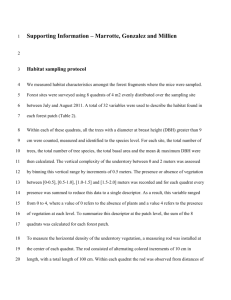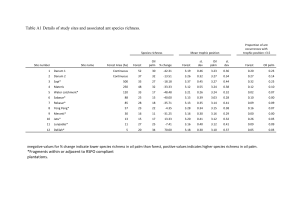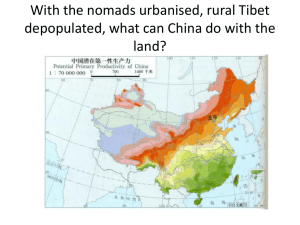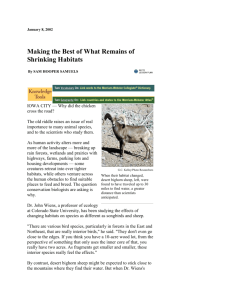Analysis of Variance (ANOVA)
advertisement
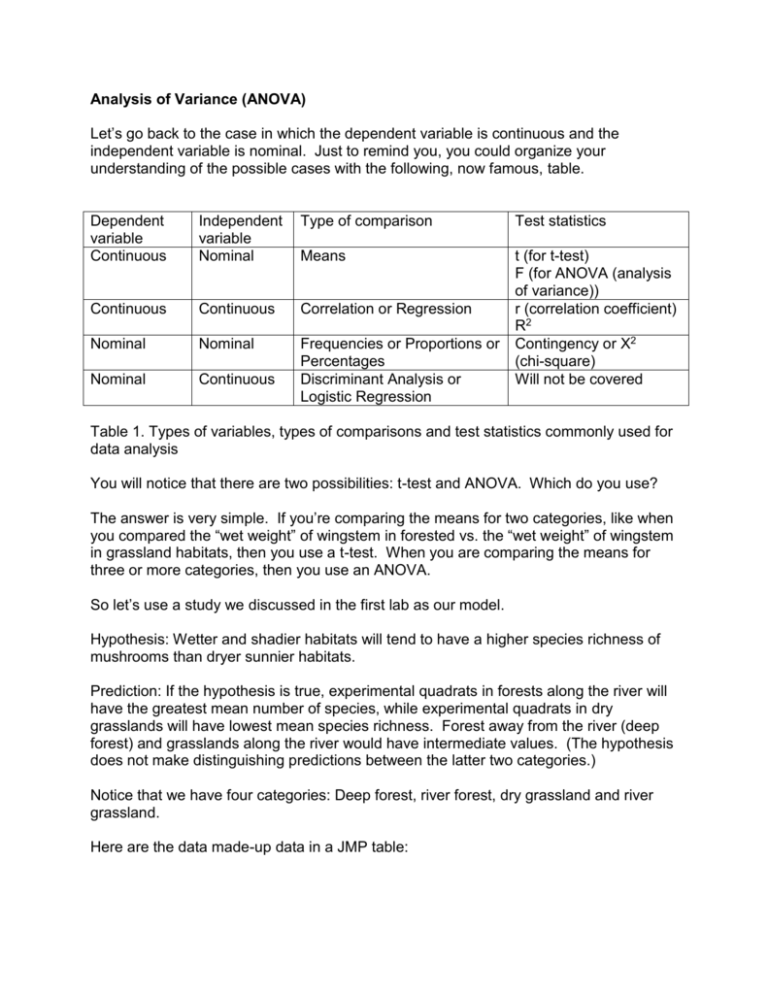
Analysis of Variance (ANOVA) Let’s go back to the case in which the dependent variable is continuous and the independent variable is nominal. Just to remind you, you could organize your understanding of the possible cases with the following, now famous, table. Dependent variable Continuous Independent variable Nominal Type of comparison Test statistics Means Continuous Continuous Correlation or Regression Nominal Nominal Nominal Continuous Frequencies or Proportions or Percentages Discriminant Analysis or Logistic Regression t (for t-test) F (for ANOVA (analysis of variance)) r (correlation coefficient) R2 Contingency or X2 (chi-square) Will not be covered Table 1. Types of variables, types of comparisons and test statistics commonly used for data analysis You will notice that there are two possibilities: t-test and ANOVA. Which do you use? The answer is very simple. If you’re comparing the means for two categories, like when you compared the “wet weight” of wingstem in forested vs. the “wet weight” of wingstem in grassland habitats, then you use a t-test. When you are comparing the means for three or more categories, then you use an ANOVA. So let’s use a study we discussed in the first lab as our model. Hypothesis: Wetter and shadier habitats will tend to have a higher species richness of mushrooms than dryer sunnier habitats. Prediction: If the hypothesis is true, experimental quadrats in forests along the river will have the greatest mean number of species, while experimental quadrats in dry grasslands will have lowest mean species richness. Forest away from the river (deep forest) and grasslands along the river would have intermediate values. (The hypothesis does not make distinguishing predictions between the latter two categories.) Notice that we have four categories: Deep forest, river forest, dry grassland and river grassland. Here are the data made-up data in a JMP table: Table 2. Made-up data of number of different species of mushrooms collected from five 10 X 10 M quadrats in each of four habitats. Notice that I have a column called “replicate”. Each replicate (or replication) is a sample of the category. Because we set up five quadrats in each habitat, we have five replicates for each of the four habitats. I put the replicate numbers in the data table because it facilitates discussion. For example I could say “replicate 3 of river forest”, and you would know I’m referring to the quadrat with 12 different species of mushrooms. Numbering your replicates is very useful for complex data tables. OK. So we want to test our Prediction that experimental quadrats in river forest will have the greatest mean number of species, while experimental quadrats in dry grasslands will have lowest mean species richness. Deep forest and river grasslands will have intermediate values. Please do the following: 1. Open or create your data file 2. .Analyze menu Fit X by Y 3. Select “species richness” as your Y,response, and “habitat” as your X, factor. Click OK. 4. You will get a graph that shows the data points for each category. Figure 1. Data points for each of four habitat categories. 5. Then click on the red triangle to the left of “oneway”, drag down to means/anova, and you should see a new window with a great deal of data on it. You will also that the graph has been redrawn, with the gray horizontal bar representing the mean number of species overall, the longer green horizontal bar representing the mean for each category, and the top and bottom of the diamond shape representing the 95% confidence intervals. Based on these samples we are 95% confident that the true mean for that category falls between the top tip and bottom tip of the diamond. We won’t worry about the meaning of the two shorter green horizontal bars for now. Here are the essential data from this table: A. In the “Summary of Fit” table, the overall mean of response = 3.8. You won’t report that, but it’s nice to know. B. In the Analysis of Variance (ANOVA) table, you will note the DF (degrees of freedom) for habitat = 3, and DF for error = 16. The F-ratio is 11.90, and P = 0.0002. You would report that as follows: “F3,16 = 11.90, P = 0.0002.” So what does this mean? Because the P-value is so low (much less than 0.05), we can support our hypothesis that species richness is significantly different for different habitats. C. In the “Means for Oneway Anova” table, you will see the means and standard errors reported for each category. Beware! Those standard errors are for the entire sample, not for the individual categories. To get the standard error for each category, click on the red triangle and drag to “Means and Std Dev.” You’ll get the following: These are the correct values for means, standard deviations, and standard errors. Your report should include (either in the text of the paper, in a figure, or in a table) the means for each category, and either the standard error of the mean, or the standard deviation. The frustrating thing is that while we now know that habitat influences mushroom species richness, we still don’t know which category is significantly different from which. In other words we still haven’t fully tested the predictions of our hypothesis. There’s only one more step. 6. Go back to that little red triangle, drag to “compare means”, then drag to all “pairs Tukey HSD”. You will get the box below: The bottom portion of this output is of relevance. You will notice that “Levels not connected by same letter are significantly different.” (for our purpose levels = categories). For example the mean (7.6) for River forest has an A next to it. Thus its mean is significantly greater than the 2 categories that don’t have an A next to them (both grassland categories), but it isn’t significantly greater than Deep forest (which also has an A next to it). Similarly Deep forest’s mean is significantly greater than Dry grassland’s mean, but not River grassland (Because Deep forest and River grassland both share the letter B). So that’s how we will be comparing means in this class when there are more than two categories for a nominal independent variable. Notice that I used the term significantly greater rather than significantly different - if the means are different I want to know which is greater than which. Have we supported, or failed to support our research hypothesis?




